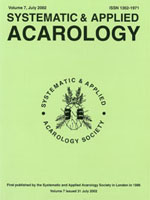To determine the principal vectors of Lyme disease in North China, the capability of I. persulcatus, H. concinna and D. silvarum to transmit Lyme spirochetes transstadially was estimated under laboratory conditions. Results suggest that all three tick species can acquire active Lyme spirochetes by feeding on infected KM mice. However, the three species vary in their ability to maintain spirochetes. Only I. persulcatus can maintain active spirochetes during molting, with subsequent tick stages infectious to innocent KM mice. Haemaphysalis concinna and D. silvarum maintain spirochetes no longer than the digestion period of blood; after molting, no spirochetes were detected in these two tick species. Therefore, I. persulcatus should be considered the principal vector of Lyme disease in North China. The presence of spirochetes in H. concinna and D. silvarum may be tied to co-feeding with I. persulcatus.
How to translate text using browser tools
1 July 2002
Ability of Ixodes persulcatus, Haemaphysalis concinna and Dermacentor silvarum to acquire and transstadially transmit the Lyme disease spirochete Borrelia garinii
Yi Sun,
Rongman Xu,
Tianyu Guo,
Panhe Zhang,
Wuchun Cao
ACCESS THE FULL ARTICLE

Systematic and Applied Acarology
Vol. 7 • No. 1
July 2002
Vol. 7 • No. 1
July 2002
D. silvarum
H. concinna
laboratory host
Lyme disease
tick
transstadial transmission




